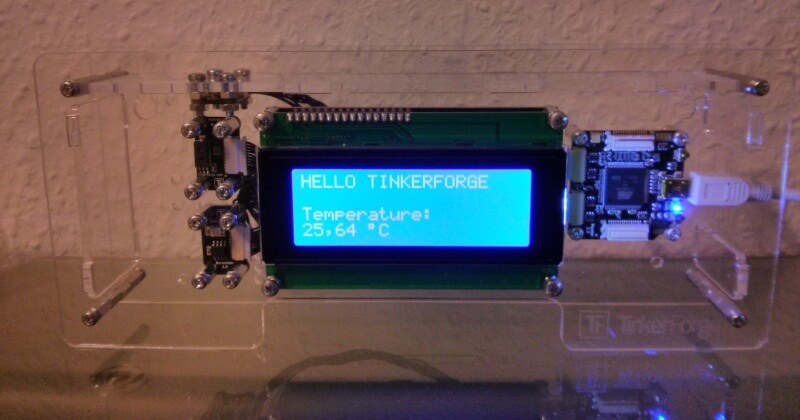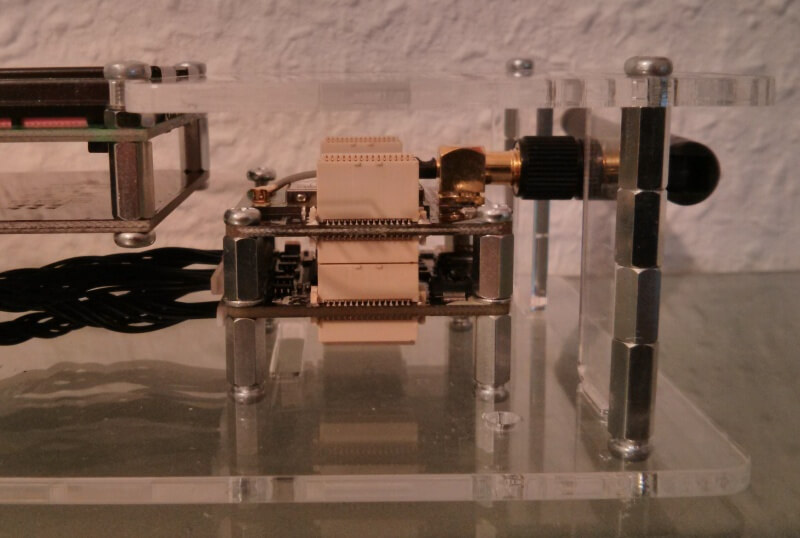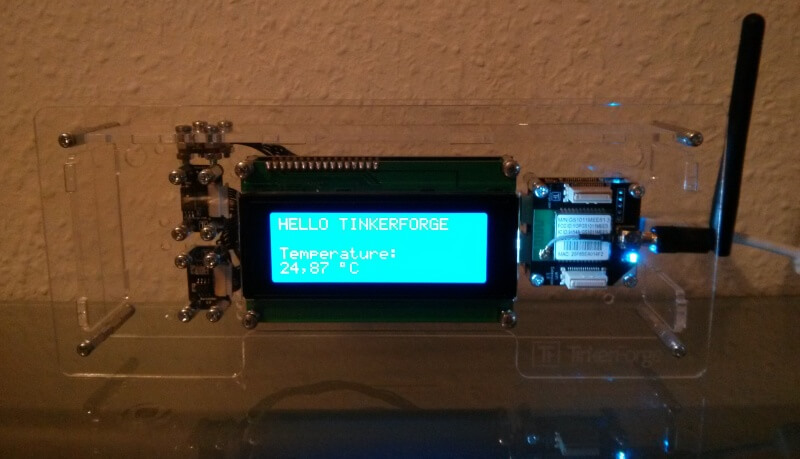Tinkerforge Weather Station, part 1 - Intro and construction
Jun 17 2013, 23:03 | tags: hardware
This post is part of a series: Tinkerforge Weather Station
- Tinkerforge Weather Station, part 1 - Intro and construction (this post)
- Tinkerforge Weather Station, part 2 - Connecting to a Raspberry PI
- Tinkerforge Weather Station, part 3 - Continuing the project after a decade
This is my first “real” try to write software for an electronic device.
Actually, I already controlled an USB Missile Launcher. But I didn’t really interact much with the hardware then, I just bought a shrink-wrapped device and figured out how to send the right commands to the USB port. So I don’t know if this really counts as “electronics”.
I was already longer interested to do something “real” with electronics/hardware, but I wasn’t sure how to get started.
For example, I looked at the Arduino first (I even pre-ordered the “Arduino in Action” book from Manning). The whole platform looks interesting, but as I have absolutely no electronics/hardware experience at all, fuddling with LEDs, resistors etc. sounds hard/complicated to me.
So I looked further and found alternatives that sounded easier to start with, for a software guy like me:
-
Even someone with little or no electronics background can build devices made up of components like sensors, lights, switches, displays, communications modules, motor controllers, and much more. Just pick your components, plug them into a mainboard and program the way they work together. .NET Gadgeteer uses the .NET Micro Framework to make writing code for your device as easy as writing a desktop, Web or Windows Phone application.
-
No detailed knowledge in electronics necessary
The realization of a project with Tinkerforge is possible without troubles. You simply pick the required modules and connect them together with each other. There is no other electronics knowledge and no soldering needed.
(…)
Intuitive API
The Tinkerforge API offers intuitive functions, that simplify the programming. For example: It is possible to set the velocity of a motor in meters per second with a call of setVelocity() or to read out a temperature in degree Celsius (°C) with getTemperature().
Yes, I can probably learn more about embedded programming and hardware by using something more “low-level” (like Arduino).
But for now I don’t want/need deep knowledge, I just want to do something cool with hardware.
There are starter kits available for both .NET Gadgeteer and Tinkerforge. I looked at the starter kits for both systems - they are a bit more expensive than Arduino starter kits, but I’m willing to pay more for ease of use.
So I thought about purchasing one of those starter kits, but I hesitated, because I didn’t have an idea for a project yet.
Then Tinkerforge announced a new starter kit.
Quote from the blog post:
Points of criticism for the old Starter Kit were the missing description of applications, assembly instructions and documentation. We want to counteract these points with a whole series of Starter Kits. The new Starter Kits will always have a specific application as well as instructions for assembly and for the usage of all of our supported programming languages.
The Idea is, that you can finish a whole project with the software and hardware as it is provided by the kit. It will however always be possible to add a whole range of modifications, extensions and improvements, so that the fun of tinkering doesn’t come short.
That sounded exactly like what I needed to get started, so I took advantage of the initial promotional discount and purchased a Weather Station Starter Kit.
Inspired by the projects described on the Tinkerforge site, my planned “end goal” is to do something similar:
I’d like to measure temperature, air pressure etc. on my terrace and display the data somewhere on this site.
But this will come later - in this post, I’ll just assemble the Basic Weather Station and write my first application for it.
Construction / Software
There’s not much to say about the actual construction - I blindly followed the instructions.
To get started with the software, I followed the “First steps” tutorial:
-
Write my first program:
This reads the temperature from the Barometer Bricklet and displays it on the LCD Bricklet:
using System;
using Tinkerforge;
namespace FirstTest
{
class Program
{
private static string host = "localhost";
private static int port = 4223;
private static string uidLcd = "ezS";
private static string uidBar = "ewy";
static void Main(string[] args)
{
var con = new IPConnection();
var lcd = new BrickletLCD20x4(uidLcd, con);
var bar = new BrickletBarometer(uidBar, con);
con.Connect(host, port);
var temp = bar.GetChipTemperature() / 100.0;
lcd.ClearDisplay();
lcd.WriteLine(0, 0, "HELLO TINKERFORGE");
lcd.WriteLine(2, 0, "Temperature:");
lcd.WriteLine(3, 0, string.Format("{0} {1}C", temp, (char)0xDF));
lcd.BacklightOn();
Console.ReadLine();
lcd.BacklightOff();
}
}
}
And there it is:

Adding Wi-Fi
I’m going to put the Weather Station on my terrace and I don’t have Ethernet there, so it needs a Wi-Fi connection.
I didn’t buy the Wi-Fi Master Extension directly with the Weather Station, because it’s not exactly cheap (59,99 €) and I wanted to make sure first that the basic Weather Station (and Tinkerforge in general) works for me.
It did, so I purchased a Wi-Fi extension next.
The instructions page says that the stack can be powered either with a Step-Down Power Supply or an USB Power Supply.
The Step-Down Power Supply makes sense when you want to power more than just the Tinkerforge Stack (for example, when you put a Raspberry PI into the Weather Station).
I will use a Raspberry PI, but I don’t intend to put it into the Weather Station (more about this in the next post), so I bought the (cheaper) USB Power Supply.
The construction was simple. I still had some spare mounting kit parts, so I just mounted the Wi-Fi Extension on top of the Master Brick with four 9mm spacers. That’s all:

Changing the software
After configuring the Wi-Fi Extension and connecting it to my home network, I tried to get the demo app from above to run again.
Fortunately, there’s not much to change because the extension causes the stack to behave exactly as if it was connected directly via USB.
Quote from the docs:
From the programming perspective this is completely transparent, i.e. all Bricks and Bricklets can be used exactly the same way as if they were connected to your controlling device via USB.
So I only had to change this line in the code:
private static string host = "localhost";
…to this:
private static string host = "192.168.0.115";
That’s enough to get it to work:

Conclusion
That was the first part. As I said before, I’m planning to control the Weather Station with a Raspberry PI.
It’s already ordered, and in the second part, I will connect it to the Weather Station.
